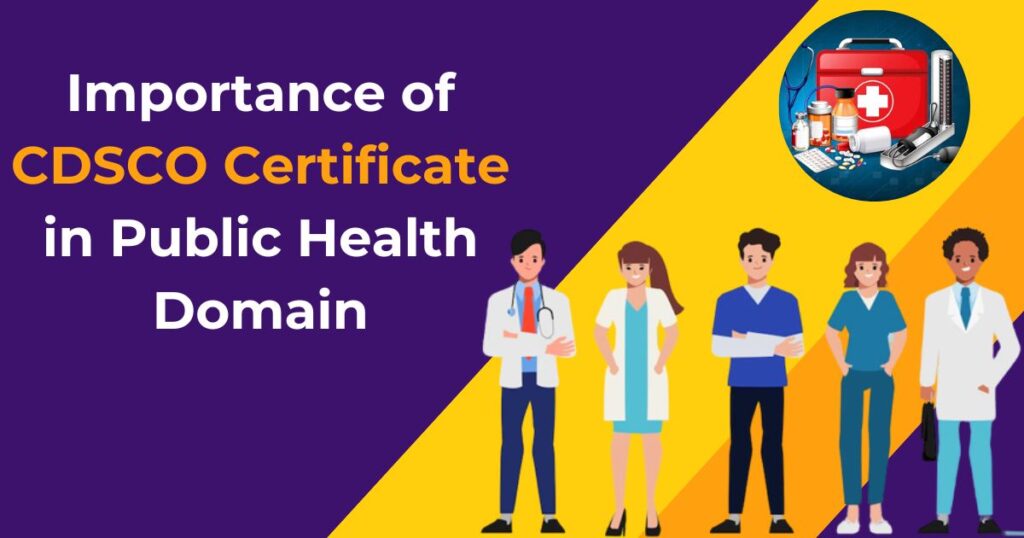Primary Role of CDSCO in the Public Health Domain

In order to regulate drugs and cosmetics, the Drugs and Cosmetics Act, 1940 and rules, 1945 have given central and state regulators a number of duties. It also envisions the uniform application of the Act's provisions.
Rules made there under for ensuring the patients' rights, safety, and well-being by regulating the drugs also, cosmetics. Objective of the CDSCO is to increase transparency, accountability, and uniformity in its services that guarantee the manufactured, imported, and/or use of medical products are safe, effective, and of high quality throughout the nation.
In order to support public health, the CDSCO Certificate in Public Health Domain performs a variety of tasks. For instance, the CDSCO is in charge of
- Approving clinical trials,
- Checking the quality of imported medicines,
- Coordinating the work of state drug control agencies,
- Offering professional advice to uphold the standards of the Drugs and Cosmetics Act, and
- Issuing and renewing licenses for a variety of medical devices and drug categories.
Through its operations, CDSCO provides the general public with standards of quality and safety.
But do you really need a CDSCO issued license?
What Does a CDSCO License Mean?
It alludes to the permission to make or manufacture medicines, disposable medical equipment, or cosmetics in India. According to the CDSCO's requirements for product registration, for example toxins don't exist in any of the products. The items contain the permitted chemicals in the permitted concentrations.
Experts that are familiar with governmental regulations oversee the entire manufacturing process.
What does CDSCO Registration Serve?
The straightforward goal of this registration is to control goods that are produced or imported in India. The government is more worried about importers, though, as it is foreign products that are the source of its worries.
Regarding this accreditation, its goals can be broken down into SAR:
S is for Safety: Because the imported goods are intended for Indian citizens, the license guarantees that they don't include any potentially dangerous ingredients.
A is for Assessment: The requirements for CDSCO SUGAM registration include a number of factors. According to those rules, the Organization must evaluate imported cosmetics and other items to make sure they adhere to regulatory requirements. The government has changed more regulations in the last ten years than it has since India gained independence.
R is for Regulations: Despite the modifications, the license guarantees that the importers follow the guidance provided by the government.
Types of CDSCO Registration
The following list includes some of the several grounds for which CDSCO may approve registration:
- Cosmetics Import and Export NOC registration according to ethical standards
- Development and Research of Blood Products and
- Blood Bank Formulations with NOC for Dual Use
- Authorized sites by BA/BE
The Role of CDSCO Certification in the Field of Public Health
A range of activities that are advantageous to public health are made possible by CDSCO accreditation. The tasks comprise:
- Establishing requirements for medications, cosmetics, and medical equipment
- Establishing legislative changes, regulations, and regulatory initiatives
- To approve the sale of new medications
- In India to control clinical trials
- As the central license approving authority, to grant permits for the production of specific classes of medications, including Blood Banks, Medical Devices, r-DNA drugs, Large Volume Parenterals, and Vaccines & Sera
- To control the requirements for importing drugs
- Drugs Technical Advisory Board (DTAB) and Drugs Consultative Committee-related activities (DCC)
- The Pharmacovigilance Program in India
- providing policy direction and coordinating the efforts of state drug control agencies to ensure uniform application of the Controlled Substances Act
- Involvement in the GMP certification programme run by the WHO
- Keeping note of medicine side effects (ADR)
- Organizing training sessions for regulatory and government analysts
But they do face challenges when they are serving in the public health domain. Let's find out some more about this:
Obstacles That Must Be Addressed For Public Health to Improve
Following are some issues with drug regulating systems:
- State-level drug control infrastructure that is insufficient or inadequate.
- Drug testing facilities that is insufficient.
- Application of laws and rules that is not uniform.
- A lack of regulatory authorities' training
- There is no database.
- Insufficient
- IT services.
Conclusion
Especially for the prevention, diagnosis, treatment, and management of all medical disorders, diseases, illnesses, and impairments, the medical devices industry in India is a crucial and fundamental part of the nation's healthcare sector. The Medical Device Sector was largely unregulated under the 1940 Drugs and Cosmetics Act until 2017, when the Central Drugs Standard Control Organization (CDSCO) passed the Medical Device Rules, 2017 for the comprehensive regulation of medical devices (M.D.s), with a focus on quality, safety, and efficacy
Also read about:
Import License for Cosmetics in India
